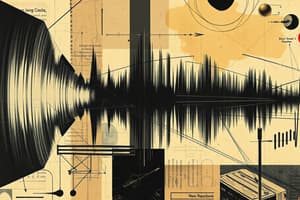Podcast
Questions and Answers
How do you come to know that a 'period' is over in your school?
How do you come to know that a 'period' is over in your school?
The sound of the bell signaling the end of the period
How is the blindfolded person able to guess which player is closest to her?
How is the blindfolded person able to guess which player is closest to her?
The blindfolded person can hear the foot steps of the other players to guess where they are.
Sound plays an important role in our lives.
Sound plays an important role in our lives.
True (A)
How is sound produced? How does it travel from one place to another? How do we hear sound? Why are some sounds louder than others?
How is sound produced? How does it travel from one place to another? How do we hear sound? Why are some sounds louder than others?
Sound is produced by a vibrating body?
Sound is produced by a vibrating body?
What do you feel when you touch the school bell when not in use?
What do you feel when you touch the school bell when not in use?
What do you feel when you touch the school bell when it is producing sound? Can you feel it vibrating?
What do you feel when you touch the school bell when it is producing sound? Can you feel it vibrating?
What is the to and fro movement of an object called?
What is the to and fro movement of an object called?
What is the number of oscillations per second called?
What is the number of oscillations per second called?
What is the amplitude of the sound a measure of?
What is the amplitude of the sound a measure of?
What does it mean to say a sound is 'shrill'?
What does it mean to say a sound is 'shrill'?
What is the unit for loudness of sound?
What is the unit for loudness of sound?
Sound can travel through a vacuum.
Sound can travel through a vacuum.
Which of these can sound travel through?
Which of these can sound travel through?
What happens to the vibrations as they pass through our eardrums?
What happens to the vibrations as they pass through our eardrums?
Noise is a pleasant sound.
Noise is a pleasant sound.
List several ways to reduce noise pollution.
List several ways to reduce noise pollution.
Flashcards
What is vibration?
What is vibration?
The back and forth motion of an object. It's what happens when an object moves repeatedly from one position to another and back again.
How is sound created?
How is sound created?
Sound is produced by vibrating objects. When something vibrates, it makes the air around it vibrate too, creating sound waves that travel to your ears.
What are vocal cords and what are their roles?
What are vocal cords and what are their roles?
The vocal cords are a pair of thin, elastic bands in your voice box. When air passes through them, they vibrate, and that's how we make sounds!
What is the voice box?
What is the voice box?
Signup and view all the flashcards
What is a medium in the context of sound?
What is a medium in the context of sound?
Signup and view all the flashcards
Why does sound not travel through a vacuum?
Why does sound not travel through a vacuum?
Signup and view all the flashcards
What is the eardrum?
What is the eardrum?
Signup and view all the flashcards
What is frequency?
What is frequency?
Signup and view all the flashcards
What is a Hertz (Hz)?
What is a Hertz (Hz)?
Signup and view all the flashcards
What determines the loudness of sound?
What determines the loudness of sound?
Signup and view all the flashcards
What is amplitude?
What is amplitude?
Signup and view all the flashcards
What is pitch?
What is pitch?
Signup and view all the flashcards
What is noise?
What is noise?
Signup and view all the flashcards
What is music?
What is music?
Signup and view all the flashcards
What is noise pollution?
What is noise pollution?
Signup and view all the flashcards
What is the audible range for humans?
What is the audible range for humans?
Signup and view all the flashcards
What are infrasonic sounds?
What are infrasonic sounds?
Signup and view all the flashcards
What are ultrasonic sounds?
What are ultrasonic sounds?
Signup and view all the flashcards
What is hearing impairment?
What is hearing impairment?
Signup and view all the flashcards
What are assistive devices for hearing impairment?
What are assistive devices for hearing impairment?
Signup and view all the flashcards
How can planting trees help reduce noise pollution?
How can planting trees help reduce noise pollution?
Signup and view all the flashcards
What type of instrument is a tabla?
What type of instrument is a tabla?
Signup and view all the flashcards
What type of instrument is a sitar?
What type of instrument is a sitar?
Signup and view all the flashcards
What type of instrument is a flute?
What type of instrument is a flute?
Signup and view all the flashcards
What type of instrument is a harmonium?
What type of instrument is a harmonium?
Signup and view all the flashcards
What is the function of the eardrum?
What is the function of the eardrum?
Signup and view all the flashcards
What is an ultrasound device?
What is an ultrasound device?
Signup and view all the flashcards
What was the unique warning system used at Golconda fort?
What was the unique warning system used at Golconda fort?
Signup and view all the flashcards
What is hearing?
What is hearing?
Signup and view all the flashcards
Study Notes
Sound Production
- Sound is produced by vibrating objects
- In humans, sound is produced by the vibration of vocal cords
- Sound travels through a medium (gas, liquid, or solid)
- Sound cannot travel in a vacuum
How Sound Travels
- Sound travels through a medium, like air, water, or solids
- Sound vibrations cause the particles in the medium to vibrate
- These vibrations are passed from one particle to another, moving the sound away from the source
Sound Needs a Medium
- Sound needs a medium to travel, like a gas, a liquid, or a solid
- Sound cannot travel through a vacuum
Hearing
- The eardrum vibrates when sound waves reach the ear
- The eardrum sends vibrations to the inner ear
- The inner ear sends signals to the brain, which interprets the sound
Loudness and Pitch
- Loudness is related to the amplitude of the vibration (larger amplitude = louder sound)
- Loudness is measured in decibels (dB)
- Pitch is related to the frequency of the vibration (higher frequency = higher pitch)
Noise Pollution
- Noise is unwanted or unpleasant sound
- Noise pollution occurs when there's excessive noise, which can negatively affect human health
- Sources of noise pollution include vehicles, machines, and construction sites
Audible and Inaudible Sounds
- The human ear can typically hear sounds with frequencies between 20 Hz and 20,000 Hz
- Sounds below 20 Hz or above 20,000 Hz are called inaudible (cannot be heard by humans)
- Animals may have different ranges of audible frequencies
Musical Instruments
- Musical instruments produce sound through vibrating parts (e.g. string, membrane)
- The vibrating part produces vibrations that create sound waves
- Examples of musical instruments include flute, tabla, harmonium, and veena
Studying That Suits You
Use AI to generate personalized quizzes and flashcards to suit your learning preferences.



